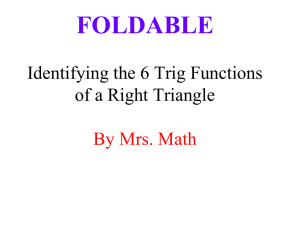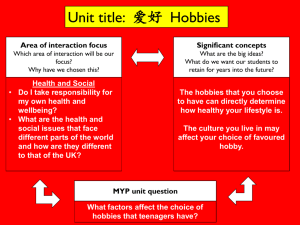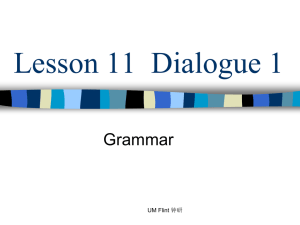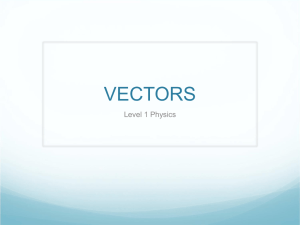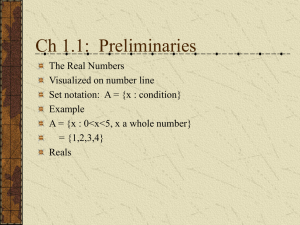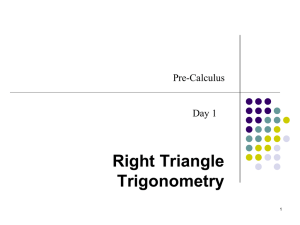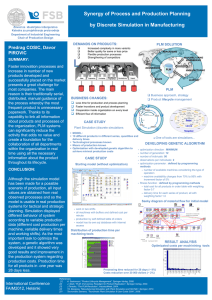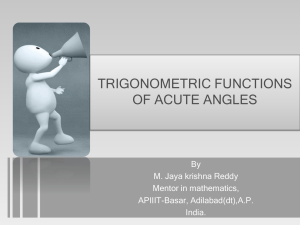powerpoint
advertisement
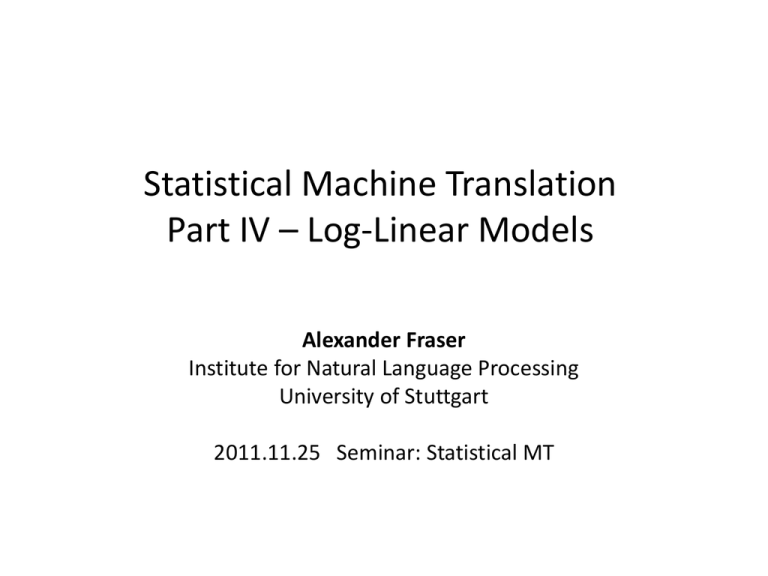
Statistical Machine Translation Part IV – Log-Linear Models Alexander Fraser Institute for Natural Language Processing University of Stuttgart 2011.11.25 Seminar: Statistical MT Where we have been • We have covered all bases! • Solving a problem where we are predicting a structured output: – Problem definition – Evaluation, i.e., how will we evaluate progress? – Model – Training = parameter estimation – Search (= decoding, for SMT) Where we are going • The generative models we have seen so far are good, but we can do better – Switch to discriminative models (this will be defined later) – We will see that this frees us from the structure of the generative model! • We can concentrate on new knowledge sources • Also, no more annoying open parameters – The kind of model I will present is used practically everywhere in NLP these days Outline • • • • Optimizing parameters Deriving the log-linear model Tuning the log-linear model Adding new features Introduction • We have seen that using Bayes’ Rule we can decompose the problem of maximizing P(e|f) argmax P( e | f ) = argmax P( f | e ) P( e ) e e a Basic phrase-based model • We make the Viterbi assumption for alignment (not summing over alignments, just taking the best one) • We know how to implement P(f,a|e) using a phrasebased translation model composed of a phrasegeneration model and a reordering model • We know how to implement P(e) using a trigram model and a length bonus PTM (f, a | e) PD (a) PLM (e) C length(e) Example Source: |Morgen| |fliege| |ich| |nach Kanada| Hyp 1: |Tomorrow| |I| |will fly| |to Canada| Hyp 2: |Tomorrow| |fly| |I| |to Canada| • What do we expect the numbers to look like? Phrase Trans Reordering Trigram LM Length bonus Hyp 1 Good Z^4 < 1 Good C^6 Hyp 2 Good Z^0 = 1 Bad C^5 < C^6 What determines which hyp is better? • Which hyp gets picked? – Length bonus and trigram like hyp 1 – Reordering likes hyp 2 • If we optimize Z and C for best performance, we will pick hyp 1 Phrase Trans Reordering Trigram LM Length bonus Hyp 1 Good Z^4 < 1 Good C^6 Hyp 2 Good Z^0 = 1 Bad C^5 < C^6 How to optimize Z and C? • Take a new corpus “dev” (1000 sentences, with gold standard references so we can score BLEU) • Try out different parameters. [Take last C and Z printed]. How many runs? Best = 0; For (Z = 0; Z <= 1.0; Z += 0.1) For (C = 1.0; C <= 3.0; C += 0.1) Hyp = run decoder(C,Z,dev) If (BLEU(Hyp) > Best) Best = BLEU(Hyp) Print C and Z Adding weights • But what if we know that the language model is really good; or really bad? • We can take the probability output by this model to an exponent PLM (e) λ LM • If we set the exponent to a very large positive number then we trust P (e) very much LM – If we set the exponent to zero, we do not trust it at all (probability is always 1, no matter what e is) • Add a weight for each component (Note, omitting length bonus here, it will be back soon; we’ll set C to 1 for now so it is gone) PTM (f, a | e) λTM PD (a) λD PLM (e) λ LM • To get a conditional probability, we will divide by all possible strings e and all possible alignments a P(e, a | f) PTM (f, a | e) e' , a' λTM PTM (f, a' | e' ) PD (a) λTM λD PLM (e) PD (a' ) λD λ LM PLM (e' ) λ LM • To solve the decoding problem we maximize over e and a. But the term in the denominator is constant! argmax e, a P(e, a | f) argmax argmax PTM (f, a | e) e, a e, a e' , a' λTM PTM (f, a' | e' ) PTM (f, a | e) λTM P D (a) λTM P D (a) λD P LM (e) P D (a' ) λD λD P LM (e) λ LM P LM (e' ) λ LM λ LM • We now have two problems – Optimize Z, C and the three lambdas – Exponentiation is slow • Let’s solve this one first… Log probabilities • • • • • • • Convenient to work in log space Use log base 10 because it is easy for humans log(1)=0 because 10 1 log(1/10)=-1 because 10 1 / 10 log(1/100)=-2 because 10 1 / 100 Log(a*b) = log(a)+log(b) Log(a^b) = b log(a) 0 1 2 So let’s maximize the log argmax e, a P(e, a | f) argmax e, a PTM (f, a | e) λTM PD (a) λD PLM (e) λ LM C length(e) So let’s maximize the log argmax e, a P(e, a | f) argmax argmax e, a PTM (f, a | e) e, a λTM PD (a) log( PTM (f, a | e) λTM λD PLM (e) P D (a) λD λ LM C length(e) P LM (e) λ LM C length(e) ) So let’s maximize the log argmax e, a P(e, a | f) argmax argmax argmax e, a PTM (f, a | e) λTM PD (a) e, a log( PTM (f, a | e) e, a log( PTM (f, a | e) log( PLM (e) λ LM λTM λTM ) log( C λD PLM (e) P D (a) λD ) log(P length(e) )) λ LM C length(e) P LM (e) (a) D λD λ LM ) C length(e) ) So let’s maximize the log argmax e, a P(e, a | f) argmax argmax argmax e, a PTM (f, a | e) PD (a) e, a log( PTM (f, a | e) e, a log( PTM (f, a | e) log( PLM (e) argmax λTM e, a λ LM λTM λTM ) log( C λD PLM (e) P D (a) λD ) log(P length(e) λ LM length(e) length(e) P LM (e) (a) D λD λ LM ) )) λTM log( PTM (f, a | e)) λ D log(P λ LM log( PLM (e)) log( C C )) D (a)) C length(e) ) Let’s change the length bonus argmax λTM log( PTM (f, a | e)) λ D log(P e, a λ LM log( PLM (e)) λ LB log(10 argmax e, a λTM log( PTM (f, a | e)) λ D log(P D (a)) length(e) D ) (a)) λ LM log( PLM (e)) λ LB length(e) We set C=10 and add a new lambda, then simplify Length penalty argmax e, a λTM log( PTM (f, a | e)) λ D log(P D (a)) λ LM log( PLM (e)) λ LP (-length(e )) We like the values we work with to be zero or less (like log probabilities) We change from a length bonus to a length penalty (LP) But we know we want to encourage longer strings so we expect that this lambda will be negative! Reordering argmax e, a λTM log( PTM (f, a | e)) λ D (-D(a)) λ LM log( PLM (e)) λ LP (-length(e )) Do the same thing for reordering. As we do more jumps, “probability” should go down. So use –D(a) D(a) is the sum of the jump distances (4 for hyp 1 in our previous example) Log-linear model • So we now have a log-linear model with four components, and four lambda weights – The components are called feature functions • Given f, e and/or a they generate a log probability value • Or a value looking like a log probability (Reordering, Length Penalty) – Other names: features, sub-models • This is a discriminative model, not a generative model Slide from Koehn 2008 Slide from Koehn 2008 Search for the log-linear model • We’ve derived the log-linear model – We can use our beam decoder to search for the English string (and alignment) of maximum probability • We only change it to sum (lambdas times log probabilities) • Rather than multiplying unweighted probabilities as it did before argmax e, a λTM log( PTM (f | e)) λ D (-D(a)) λ LM log( PLM (e)) λ LP (-length(e )) Discriminative training problem: optimizing lambda • We are looking for the best lambda vector – A lambda vector consists of lambda scalars (4 for our model right now) • How do we get an optimal lambda vector? • We can use nested for-loops as we did before for C and Z – We need to try out a lot of values for the lambda scalars though, the differences could be very subtle – Many, many decoder runs; these take 10 minutes or longer each! • At least we can reduce number of decoder runs – Use n-best lists Slide from Koehn 2008 Slide from Koehn 2008 Learning Task Source: |Morgen| |fliege| |ich| |nach Kanada| Hyp 1: |Tomorrow| |I| |will fly| |to Canada| Hyp 2: |Tomorrow| |fly| |I| |to Canada| Assume that Hyp 1 has a better BLEU score Phrase Trans Reordering Trigram LM Length Hyp 1 -1 -4 -3 -6 Hyp 2 -1 0 -5 -5 Learning Task Suppose we start with an initial lambda vector: 1 1 1 -1 Then: hyp 1 has a log score of -2 (1/100 probability) hyp 2 has a log score of -1 (1/10 probability) This is poor! Hyp 2 will be selected Phrase Trans Reordering Trigram LM Length Hyp 1 -1 -4 -3 -6 Hyp 2 -1 0 -5 -5 Learning Task We would like to find a vector like: 1 0.5 2 -1 hyp 1 has a log score of -3 hyp 2 has a log score of -6 Hyp 1 is correctly selected! Phrase Trans Reordering Trigram LM Length Hyp 1 -1 -4 -3 -6 Hyp 2 -1 0 -5 -5 Learning Task N-best lists contain several sentences and hypotheses for each sentence The lambda vector 1 0.5 2 -1 picks Hyp 1 in the first sentence, and Hyp 2 in the second sentence. Suppose sentence 2 Hyp 1 is better. Then choose a lambda like: 3 0.5 2 -1 It is easy to see that this does not change the ranking of the hypotheses in sentence 1. Sentence Hypothesis Phrase Trans Reordering Trigram LM Length bonus 1 Hyp 1 -1 -4 -3 -6 1 Hyp 2 -1 0 -5 -5 2 Hyp 1 -2 0 -3 -3 2 Hyp 2 -3 0 -2 -3 N-best lists result in big savings • Run the for-loops on a small collection of hypotheses, do decoder runs only when you have good settings Initialize: start with empty hypothesis collection LOOP: – Run the decoder with current lambda vector and add nbest list hypotheses to our collection – Score collection of hypotheses with BLEU – Use nested-for-loop to change individual lambda scalars in vector to get better BLEU on collection – End program if lambda vector did not change • OK, so we know how to set the lambda vector for our four feature functions – This means depending on the task we might, for instance, penalize reordering more or less – This is determined automatically by the performance on the dev corpus • But what about new features? New Feature Functions • We can add new feature functions! – Simply add a new term and an associated lambda • Can be anything that can be scored on a partial hypothesis – (remember how the decoder works!) – Can be function of e, f and/or a – Can be either log probability (e.g., Trigram), or just look like one (e.g., Length Penalty) • These can be very complex features to very simple features – Length penalty is simple – Phrase translation is complex – With right lambda settings they will trade-off against each other well! New Feature Functions • Features can overlap with one another! – In a generative model we do a sequence of steps, no overlapping allowed – In Model 1, you can’t pick a generated word using two probability distributions • Note: Interpolation is not an answer here, would add the optimization of the interpolation weight into EM • Better to rework generative story if you must (this is difficult) – With a log-linear model we can score the probability of a phrase block using many different feature functions, because the model is not generative Slide from Koehn 2008 Revisiting discriminative training: methods to adjust feature weights • We will wind up with a lot of lambda scalars to optimize • But there are algorithms to deal with this that are more efficient than nested for-loops • In all cases, we have the same log-linear model – The only difference is in how to optimize the lambdas – We saw one way to do this already • Using nested for-loops on n-best lists – We will keep using n-best lists (but not nested for-loops) Minimum Error Rate Training – Maximize quality of top-ranked translation • Similarity according to metric (BLEU) • Implemented in Moses toolkit Slide from Koehn 2008 MERT is like “un-nesting” the for-loops StartLambda = 1 1 1 -1 LOOP: BestBLEU[1..4] = 0 For (i = 1 to 4) TryLambda = StartLambda For (L = 1.0; L <= 3.0; L += 0.1) TryLambda[i] = L Hyp = best_hyps_from_nbest_list(TryLambda) If (BLEU(Hyp) > BestBLEU[i]) BestBLEU[i] = BLEU(Hyp) BestLambda[i] = L Then simply check BestBLEU[1..4] for the best score. Suppose it is BestBLEU[2]. Set StartLambda[2] = BestLambda[2] and go to top of loop (until you get no improvement). However MERT is better than that • We will not check discrete values (1.0, 1.1, …, 3.0) • We will instead do an exact line minimization in one pass through the n-best list Slide from Koehn 2008 Slide from Koehn 2008 Slide from Koehn 2008 Minimum Error Rate Training [Och, ACL 2003] • Maximize quality of top-ranked translation • Similarity according to metric (BLEU) • This approach only works with up to around 20-30 feature functions • But very fast and easy to implement • Implementation comes with Moses Maximum Entropy [Och and Ney, ACL 2002] – Match expectation of feature values of model and reference translation – Log-linear models are also sometimes called Maximum Entropy models (when trained this way) – Great for binary classification, very many lightweight features • Also is a convex optimization – no problems with local maxima in the optimization – Doesn‘t work well for SMT Ordinal Regression [Chiang et al., NAACL 2009; many others previously] – Separate k worst from the k best translations • E.g., separate hypotheses with lowest BLEU from hypotheses with highest BLEU • Approximately maximizes the margin • Support Vector machines do this non-approximately (but are too slow) • • • • Research on this for previous 6 years without success David Chiang apparently has it working now Scales to thousands of features! But requires good weight initializations , ability to efficiently get hypotheses for one sentence at a time, and lots of other details • There will be more results on this soon, being added to Moses Conclusion • We have defined log-linear models • And shown how to automatically tune them • Log-linear models allow us to use any feature function that our decoder can score – Must be able to score a partial hypothesis extended from left to right (Lecture 3) • Log-linear models are used almost everywhere (also in non-structured prediction) • Thanks for your attention! Slide from Koehn 2008
